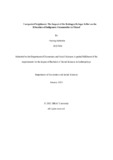| dc.contributor.advisor | Rahman, Dr. Shahidur | |
| dc.contributor.author | Sabastini, Priyong | |
| dc.date.accessioned | 2024-01-10T06:44:22Z | |
| dc.date.available | 2024-01-10T06:44:22Z | |
| dc.date.copyright | 2023 | |
| dc.date.issued | 2023-01 | |
| dc.identifier.other | ID: 19117010 | |
| dc.identifier.uri | http://hdl.handle.net/10361/22102 | |
| dc.description | This thesis is submitted in partial fulfillment of the requirements for the degree of Bachelor of Social Science in Anthropology, 2023. | en_US |
| dc.description | Cataloged from PDF version of thesis. | |
| dc.description | Includes bibliographical references (pages 75-80). | |
| dc.description.abstract | Following the genocide on the Rohingya people in Myanmar back in August 2017,
about 1 million refugees have entered Bangladesh, which has created astronomic pressure on
the host community. Beyond immediate issues of accommodation and social cohesion that
have risen, a secondary challenge has been the impact of the refugee camps on the education.
In this context, this dissertation examines the impact of the Rohingya refugee camps on the
education of nearby indigenous community members and how all the immediate effects due
to the creation of camps synergise and decrease their ability for them to access education.
This research focuses on the indigenous community members in order to explore how
difficult it may be for them to cope with such difficulties because of their
already-marginalised status, hence, their lack of social and cultural capital compared to their
Bengali counterparts. Given the paucity of data on indigenous communities and their
education as well as a lack of detailed information on the impact of the camps on the host
community, the following research is a qualitative and exploratory study, where its primary
data has been directly collected from the effected members through focus group discussions,
and also NGO experts through one-on-one interviews. The subsequent findings of this
research indicate that due to the combination of factors such as increased distance, lack of
mobility, the additional responsibility of accompanying children, decrease in financial
capacities, following the creation of the refugee camps, and finally, Covid-19, school
attendance had greatly reduced and dropout rates also increased for the children of the
indigenous Chakma communities of Teknaf. The aforementioned findings have been
analysed using Amartya Sen’s theory of social exclusion and capabilities deprivation to
understand how the reduced access to education may shift the community’s ability to cope
with economic or social adversities that go beyond simply education. The following
dissertation therefore contributes to existing studies standing as research conducted solely on the indigenous communities near the refugee camps and to existing theory by showcasing
how lack of access to functional resources impact their capabilities to cope with adversities
and how under specific circumstances, an external community has the capability to further
marginalise a nation’s own members. | en_US |
| dc.description.statementofresponsibility | Priyong Sabastini | |
| dc.format.extent | 85 pages | |
| dc.language.iso | en | en_US |
| dc.publisher | Brac University | en_US |
| dc.rights | Brac University theses are protected by copyright. They may be viewed from this source for any purpose, but reproduction or distribution in any format is prohibited without written permission. | |
| dc.subject | Rohingya refugee | en_US |
| dc.subject | Education | en_US |
| dc.subject | Indigenous communities in Teknaf | en_US |
| dc.subject.lcsh | Rohingya (Burmese people)--Relocation--Bangladesh--Cox's Bāzār District. | |
| dc.subject.lcsh | Refugees--Bangladesh. | |
| dc.subject.lcsh | Cox's Bāzār District (Bangladesh)--Social conditions. | |
| dc.title | Unexpected neighbours: The impact of the rohingya refugee influx on the education of indigenous communities in Teknaf | en_US |
| dc.type | Thesis | en_US |
| dc.contributor.department | Department of Economics and Social Sciences, Brac University | |
| dc.description.degree | BSS in Anthropology | |

